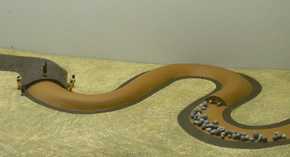SERPENT MOUND
THE BEAUTY OF THE EFFIGY
Nobody is indifferent to snakes. Whether it was veneration or trepidation that inspired its builders,
a creature’s beauty and power are obvious. Like all great art, it appeals to us by blending the recognizable
with the abstract: its stylized precision speaks to us of “all serpents”, and more generally of “the serpentine”
as an aesthetic quality.
The three coils seem perfectly uniform from above, and yet as they unwind across the
saddle of the hill, they gently undulate, giving the creature’s body a slithering, lifelike energy. The tail
is a perfect spiral, angled gently outwards toward the cliff and valley below.
The head is so beautifully abstracted that it has baffled its archaeological interpreters for decades: is it
an egg, a frog, or the sun? Is it the snake’s open mouth, its giant never-blinking eye, or its poison glands?
Squier and Davis described how the builders modified the ground considerably in order to create symmetrical,
ten-foot-wide surfaces along both sides of this oval figure.
The refined geometry has attracted, yet baffled,
all interpreters: typical analyses can get close to finding rational, or numerical formulae, including the
oft-cited solar alignments, but everything is just a little bit off – perhaps too subtle for our methods today.
We know that the design was laid out all at once, with a layer of clay and ash, and reinforced with stones.
The genius of its designers remains apparent: this blend of beauty, familiarity, abstraction, power, precision,
and mystery, make Ohio’s Serpent Mound one of the great, iconic images for all of human antiquity.

A model in the museum shows how the body of the serpent was constructed over a stone-reinforced clay surface.


